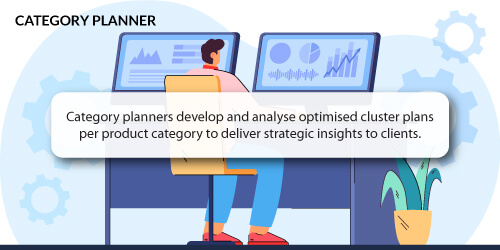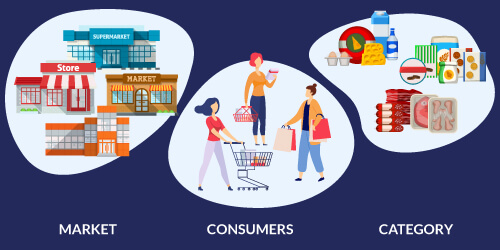For all the talk about how to find retail success, there is only one way to achieve it. And that's through planning. More specifically, it's through efficient category planning. If you have a well thought out category plan* to follow, you'll know exactly where you need to end up to experience success. More importantly, you know what steps you need to take to get there.
Fortunately, there are category planners who can help you.

They can help you achieve your goals by creating strategic assortment plans and planning and building data-driven shelf plans to maximise customer and category performance. But what if you want to do this yourself?
For effective category planning, you need a practical plan that considers all the critical elements. Why? By focusing on these characteristics - the finer details that make up your plan - success will take care of itself.

1. You must know your category definition and roles
When developing a category plan, you must begin by defining your category clearly before understanding its role.
Here's why:
Your category definition sets the foundation for which products to carry in-store and determines how you will merchandise them on the shelf. There is also the point that what you do here affects how your customers view and shop in your store.
When deciding your category definition, it usually comes down to understanding the consumer decision tree (CDT). That's because the CDT depicts, through questions, how your customers shop in the category.
For example, when buying a cold drink, they could run through a few questions and decide based on flavour, brand or size. They could choose based on price, depending on whether your target market is price-sensitive or not.
They'll ask the same questions, if not similar when choosing any other product.
As for the role, it determines the breadth of products that you'd carry for the category. In other words, the number of brands and how many variants. Logically, the role flows into your category strategy and determines the range focus and how you approach your target market.
Let's say, for example, you want to give your category a Destination role. In that case, you should include as wide a variety of products as possible to foster your reputation as the store of choice for that category. You won't want your customers to leave your store thinking you can't offer them what they want.

2. You must analyze all relevant retail data
Alongside defining your category and establishing its role, you also need to gather, analyse and understand your retail data.
Now, we've mentioned the importance of understanding your retail data before. But that doesn't mean we shouldn't re-emphasise its role. Because without access to data, any decisions you make around your retail business are guesses at best.
Of course, there are all sorts of data to consider. For the sake of your category and understanding how to plan it best, the retail data we're focusing on concerns your market, consumers, and categories.

Market
If you look at your market data, it provides you with the necessary information to understand how the category in your store performs versus that of your competitors.
For example, is Category A performing at the same level or better than your direct competitor? If yes, you know that what you're doing is working. If not, it's time to reassess and find out where you can improve.
Access to this data also allows you to identify trends and future opportunities or threats so you can act accordingly. However, remember this: it's not easily accessible, and you likely need to collaborate with your suppliers to get it.
Consumers
Turning to your consumer data, this is just as critical, if not even more so, as it provides you with a better understanding of your customers and how they shop in your store.
While you'd likely need to purchase market data to access it, you can gather customer data directly from your point of sales system.
With this information, you can make better decisions on what products to stock and how to improve the customer experience.
Categories
The data around your categories allows you to look for opportunities within your product groupings. These opportunities come from different perspectives, namely:
-
Pricing;
-
Product Assortment;
-
Placement; and
-
Promotion.
It also highlights both brand and product performance trends, which can drive any merchandising decisions that will influence both product positioning and shelf space.

3. You must consider and implement a process
Do you want to organise your categories into independent business units to produce favourable results? Then you need a process. And what better method to use than a process that centres around category management?
After all, category management aims to help you provide your customers with the products they want, where they want them, and when they want them. Implementing such a process also goes a long way to set yourself up as a store that shoppers shop at again.
Similar to how we set this article up, any category management process includes first defining your categories and determining their roles. There is also the step known as 'Insight Generation', which refers to our above point around retail data.
Beyond that, there is the step of strategic and tactical planning, driven by the insight you generate and the penultimate stage, where you need to assess the cost of your plan against the benefits.
It's also worth pointing out that each step within the category management process is interdependent. That's especially true if you use category management software such as DotActiv. More about that in the next section.
How so? Simple: a half dozen merchandising strategies make up the strategic and tactical planning stage, which you can use for your categories. The one you ultimately choose when planning your product grouping comes down to the role you give it.
For example, if you've given Category B a Convenience role, it would be better to implement an image-enhancing strategy instead of a turf-defending strategy. While the former focuses on improving your retail image and reputation, the latter is suited to a retail brand looking to protect its market share.
That said, each step builds on the other to the point that by the end of the process, you'll have a thorough plan that will enable you to achieve what you want. But be careful: if you leave out any of these steps or implement them incorrectly or clumsily, you'll struggle to accomplish your goals and objectives.

4. Invest in a robust category management toolset
While the category management process can assist you in laying down a foundation to meet your customer's needs, it's only a process.
To fully realise such a process, you need to supplement it with the right toolset. In short, category management software. There are usually three primary category management toolsets to use.
-
Planogram software;
-
Assortment Planning software; and
-
Retail Analytics software

Planogram software
As mentioned in a previous article, if you're interested in maximising your store performance and customer experience, you should consider planograms. That's not a suggestion as much as a recommendation. Planograms are worth it.
But we're going to go a step worth and say this: if you want to build performance-enhancing planograms, specialist software is a must.
That's because of these simple facts or benefits:
-
Planogram software is critical for effective stock replenishment;
-
Planogram software helps you meet customer expectations; and
-
Planogram software helps you monitor the performance of your products so you can provide each with the shelf space they deserve.
As for the consequences of not investing in this planogram software, there are many, and you'd do well to avoid them.
Assortment Planning software
If you're looking to meet your customers' needs, an assortment planning tool is ideal since it allows you the opportunity to create customised product assortment plans.
These customised plans not only ensure your store is more attractive to shoppers since you have the products they want. These plans will also improve the profitability and efficiency of your categories.
Using standard rules, templates and plans built into specialist assortment planning software such as DotActiv, you can customise your strategies for each grouping. That means you can cater for individual shoppers instead of the general market.
That’s DotActiv’s Range Optimizer solution: a one-stop solution for the different goals, strategies and objectives you have for your categories.
Retail Analytics software
By using retail analytics software, you can connect with multiple data sources and build customised dashboards to share with your team. This holistic understanding of what’s happening in your retail business is critical to your short- and long-term success.
Then there is the point that such software also allows you to create actionable category reviews that you can customise to your needs.
Of course, this isn't only for retailers. If you're a supplier interested in negotiating for more shelf space for your product, you can use category analysis and retail data to prove why you deserve more.

5. Don’t underestimate the impact of collaborating with your suppliers
It’s no secret that category management is a resource-intensive exercise. That’s especially true if you are a small to medium retailer with a tight budget.
So, to shoulder the financial responsibility, it’s worth turning to your suppliers to help fund it. Of course, there is more to supplier collaboration than just the financial support you’ll receive.
If you’ve chosen a category captain, for example, you can expect them to help you decide which products should be on the shelf, how much space each product deserves, and even develop planograms on your behalf. If you’ve chosen your category captain wisely, you’ll have a partner who looks after the well-being of the category, which will also positively impact your results.
If you’ve taken a centralised approach to category management, you can still get your suppliers involved. Here, it’s about calling on your suppliers to provide input when needed. Since your supplier has a unique perspective and access to the information you might not have, it’s always a good idea to keep them involved.
A third approach is to go the category partner route. It is the most collaborative and least biased approach to category management, as everyone has an equal say in how you present and merchandise your category in-store.
That said, this is all about the factors you need to consider when planning your category. By their nature, your suppliers will want to help you. Because if they can provide valuable information that will see growth within the category, that places them in a prime position as a reliable partner.

Conclusion
If you’re a retailer or supplier that wants to experience success, you must plan for it. Because, as with anything else, if you don’t for your success, how can you expect to achieve it?
Above are the factors that you must consider whenever setting up your next category plan. Whether you decide to use them or not is up to you. But let us ask you this? Do you want to see success?
Do you need help setting up your next category plan for your store? Or maybe you're looking for best-in-class category management software that enables you to deliver on your category goals and objectives. Why not book a complimentary custom exploratory meeting with a DotActiv expert here to find out more or browse our various software editions and services on our online store here?


